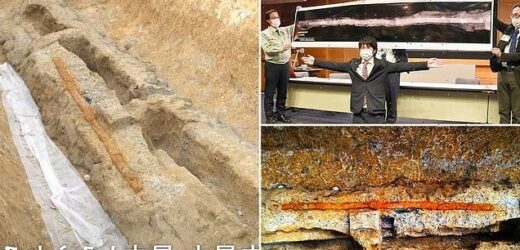Giant 7-foot-long ‘demon slaying’ sword is discovered in a 1,600-year-old tomb in Japan: Archeologists say weapon was laid by the dead to help them fight evil spirits in the afterlife
- An iron sword – designed for warding off demons – was found in a burial mound
- A shield made from a mirror was also uncovered, suggesting the tomb belonged to an elite person who may have been in the military
- READ MORE: Modern Japanese populations descended from 3 ancient cultures
A giant seven-foot-long ‘demon slaying’ sword that lay buried for more than 1,600 years has been found in Japan.
The iron weapon was uncovered in a tomb from the Tomiomaruyama burial mound in Nara, and is believed to have been placed there to help the deceased ward off evil spirits in the afterlife.
Archaeologists discovered a 16-foot-long wooden coffin deep in the mound, which housed the sword and a two-foot-long shield constructed from a mirror.
While many demon-slaying swords have been found in Japan, it is the largest and oldest found in the country.
The ‘national treasures’ suggest that the individual in the tomb was an elite who may have been in the military.
Archaeologists have discovered a seven-foot-long sword in a 1,600-year-old tomb, which they said was to help the dead fight evil spirits in the afterlife
Since last year, archaeologists have been pulling layers of dirt away from the burial mound that measures 350 feet across and up to 32 feet high.
The mound is known as ‘kofun’ after the Kofun period of Japanese history when they were built between 300 AD and 710 AD, Live Science reports.
‘So far, we have conducted aerial laser surveys (first survey) and excavation surveys (second to fifth surveys), and obtained important results in clarifying the structure of the burial mounds,’ archaeologists shared in a press release announcing the discovery.
The survey showed ‘ritual’ spaces confined within the mound, which led the team to a grave pit where a clay box housing the coffin sat.
‘The coffin is believed to have been placed in a deeply recessed portion of the bottom of the grave pit, and a thin layer of clay and sand was leveled about 30cm outside the position where the coffin lid would be placed,’ according to the archaeologists.
And inside the coffin were the giant sword and mirror.
The six-inch blade sword, known as dakō, was likely never used but only fashioned to be laid with the deceased in the mound.
The iron weapon was uncovered from the Tomiomaruyama burial mound in Nara in a tomb to help the deceased ward off evil spirits in the afterlife
The sword was buried in a layer of clay that still held the outline of the weapon when archeologists found it
The dakō sword was designed with an undulating blade reminiscent of a snake and, due to its massive size, the researchers initially thought they had found multiple swords lined up next to each other, reports Kyodo News.
This artifact is also the oldest ‘demon-slaying’ weapon found in Japan – more than 80 have been found throughout the country.
The mirror, shaped like a tortoise shell and fashioned from copper, was leaning diagonally to match the shape of the clay that covered the coffin lid.
There is a knob on the back and ‘other patterns centering on the sawtooth pattern, and it is a bronze mirror like no other,’ the team shared.
Archaeologists discovered a 16-foot-long wooden coffin deep in the mound, which housed the sword and a two-foot-long shield constructed from a mirror
The mirror weighs 125 pounds and an X-ray detected tin, copper, and lead. It is also the first ever discovered in a burial mound in Japan
‘The surface is smooth and polished, and it is believed to have been made by a Japanese mirror craftsman.’
The mirror weighs 125 pounds and an X-ray detected tin, copper, and lead.
It is also the first ever discovered in a burial mound in Japan.
Within Japanese culture, mirrors are one of the most potent symbols of power, revered as sacred objects representing the gods.
There is also the belief that mirrors connect our world with the spiritual world.
‘(These discoveries) indicate that the technology of the Kofun period are beyond what had been imagined,’ Kosaku Okabayashi, the deputy director for Nara Prefecture’s Archaeological Institute of Kashihara, told Kyodo News.
. ‘They are masterpieces in metalwork from that period.’
Source: Read Full Article







